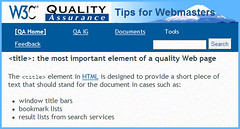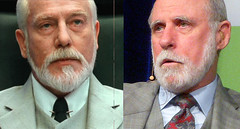Welcome to Natural Search Blog
Natural Search Blog provides articles on search engine optimization including keyword reasearch, on-page factors, link-building, social media optimization, local search optimization, image search optimization, and mobile SEO.
In addition to natural search optimization topics, we also cover internet marketing, ecommerce, web design, usability, and technology.
Recent Entries
Power Searching With Google’s New Search Options Feature
Google introduced the all new Search Options at its Searchology 2009 event. This is a useful feature that lets users slice and dice search results in various ways.
Here’s an example:
Possible Related Posts
Posted by Ravi of Netconcepts Ltd. on 05/27/2009
Permalink | |  Print
| Trackback | Comments (0) | Comments RSS
Print
| Trackback | Comments (0) | Comments RSS
Filed under: Search Engine Optimization Add new tag, Google Search Options, google searchology, reviews search, sentiment analysis, time period search, wonder wheel
Google Supports Microformats, Rolls Out Rich Snippets
The annual Google Searchology conference held recently revealed some interesting offerings in the search marketing field. Google had introduced personalised search and universal search through the same event in previous years.
Google has stated its support for rich microformats. Yahoo’s Search Monkey has already implemented them. But is still not clear if the search engines read them. Local search results have been rumoured to use microformats but there is no evidence to back this either.
(more…)
Possible Related Posts
Posted by Ravi of Netconcepts Ltd. on 05/27/2009
Permalink | |  Print
| Trackback | Comments (0) | Comments RSS
Print
| Trackback | Comments (0) | Comments RSS
Filed under: General, Search Engine Optimization Google Profiles, Google Search Options, google searchology, hcalendar, hCard, microformats, RDF, rich snippets
Microformats Hit Mainstream!
 Over on SEMClubhouse I’ve written up a post on “Why Use Microformats?” which is a mild criticism of Michael Gray’s recent post on “HCards, Microformats and Address Data does it Matter for SEO“. Essentially, Michael suggests people should prioritize implementation of hCard into local info webpages as a lower-priority, back-burner project. I not only believe that Yahoo’s SearchMonkey developer platform and Google’s new Rich Snippets display are proving that the search engines consider the Microformats protocol to be important, but anything presented as a back-burner or rainy-day project for many major corporations pretty much relegates that work to never be done at all.
Over on SEMClubhouse I’ve written up a post on “Why Use Microformats?” which is a mild criticism of Michael Gray’s recent post on “HCards, Microformats and Address Data does it Matter for SEO“. Essentially, Michael suggests people should prioritize implementation of hCard into local info webpages as a lower-priority, back-burner project. I not only believe that Yahoo’s SearchMonkey developer platform and Google’s new Rich Snippets display are proving that the search engines consider the Microformats protocol to be important, but anything presented as a back-burner or rainy-day project for many major corporations pretty much relegates that work to never be done at all.
With the advent of Rich Snippets in SERPs, I think I can safely declare that Microformats have now hit mainstream! (more…)
Possible Related Posts
Posted by Chris of Silvery on 05/20/2009
Permalink | |  Print
| Trackback | Comments (0) | Comments RSS
Print
| Trackback | Comments (0) | Comments RSS
Filed under: Best Practices, Content Optimization, Google, HTML Optimization, Local Search Optimization, Search Engine Optimization, SEO Google, hcalendar, hCard, hproduct, hreview, Local Search, local-SEO, microformats, microformatting, rich snippets, Search Engine Optimization, searchmonkey, semantic code, semantic markup
Key to Relevance: Title Tags
I recently penned an article at Search Engine Land on Leveraging Reverse Search For Local SEO. In it, I describe how in certain exception cases, one may benefit from adding the street address into a business site’s TITLE tag. It’s not the first time that I have mentioned how TITLE tags are key to relevance in Local Search — I’d previously mentioned how critical it is for local businesses to include their category keywords and city names in the TITLE as well.
Yet, a great many sites continue to miss this vital key to relevance, and they wonder why they fail at ranking for their most apropos keywords. Keywords for which they’d otherwise have a very good chance at ranking upon!

W3C calls the TITLE the “most important element of a quality web page” (more…)
Possible Related Posts
Posted by Chris of Silvery on 04/10/2009
Permalink | |  Print
| Trackback | Comments (0) | Comments RSS
Print
| Trackback | Comments (0) | Comments RSS
Filed under: Best Practices, Content Optimization, General, Google, HTML Optimization, Keyword Research, Local Search Optimization, Search Engine Optimization, SEO, Tricks key relevance, Keyword-Positions, Keyword-Rankings, page-titles, SEO, title-tags, w3c
Town Changes Name For Better Google Rankings
This is just too cool to pass up mentioning in local search news: a town in Europe has decided to change it’s name in order to get better rankings in Google!
 The town of “Eu” in France has been edged out of search rankings for the term, since other pages about the European Union are ranking higher. According to them, they’re missing out on a lot of tourism because individuals simply cannot find information about them.
The town of “Eu” in France has been edged out of search rankings for the term, since other pages about the European Union are ranking higher. According to them, they’re missing out on a lot of tourism because individuals simply cannot find information about them.
I’ve previously blogged in Ultimate Local SEO Tactics a tongue-in-cheek post recommending changing a town’s name for search optimization purposes, but I didn’t think it would actually happen!
Now, I’d say they possibly could save some money/trouble by first hiring some SEOs to try to help them rank for the term. For instance, it might be possible to get the Wikipedia page for Eu to rank on the first page.
In fact, I’ll call for a bit of generous community action here – why don’t all you other local SEO’s out there blog about this city and link to their Wikipedia page as well? Let’s help that poor town out!
Possible Related Posts
Posted by Chris of Silvery on 02/26/2009
Permalink | |  Print
| Trackback | Comments (0) | Comments RSS
Print
| Trackback | Comments (0) | Comments RSS
Filed under: Local Search, Local Search Optimization, SEO EU, Local Search Optimization, local-SEO, Search Engine Optimization, SEO
Vint Cerf & The Architect in The Matrix
While attending and speaking at the recent SMX West conference in Santa Clara, I had the opportunity to photograph Vinton (“Vint”) Cerf, Google’s VP and Chief Internet Evangelist during his keynote interview conducted by Chris Sherman.
After returning, one of my friends saw my pics and remarked that Vint Cerf resembled the Architect character in the Matrix movies. It immediately struck me that he was right — so I knocked together a comparison pic:
Vint Cerf and the Architect in the Matrix share a number of feature similarities: similar age, dress, coloring, and facial hair. The biggest difference is that the Architect has a full head of hair while Vint is balding. (more…)
Possible Related Posts
Posted by Chris of Silvery on 02/20/2009
Permalink | |  Print
| Trackback | Comments (0) | Comments RSS
Print
| Trackback | Comments (0) | Comments RSS
Filed under: Conferences, Futurism, Google Architect, Chris-Sherman, Google, The Matrix, Vint Cerf
AT&T Acquires YP.com for $3.85 Million
![]() AT&T has acquired YP.com for $3.85 Million. I distinctly recall back when AT&T previously bought YellowPages.com in for $100 million in 2004. Does this make sense?!?
AT&T has acquired YP.com for $3.85 Million. I distinctly recall back when AT&T previously bought YellowPages.com in for $100 million in 2004. Does this make sense?!?
Back in 2004, I laughed and laughed and laughed, and I told coworkers that it was a huge waste of money, because, I said, “they won’t be able to buy themselves into the top position for searches for ‘Yellow Pages'”. SuperPages.com long held that distinction under my SEO direction, and I knew that purchasing the term in a domain name alone would not depose all the work we’d done to rank tops for it. As time passed, however, yellowpages.com has indeed deposed the Superpages forerunner. (more…)
Possible Related Posts
Posted by Chris of Silvery on 01/14/2009
Permalink | |  Print
| Trackback | Comments (0) | Comments RSS
Print
| Trackback | Comments (0) | Comments RSS
Filed under: brand names, Domain Names, Online Directories, Search Engine Optimization, SEO, URLs, Yellow Pages AT&T, Domain Names, Yellow Pages, yellowpages.com
Flickr *IS* Good for Search Marketing – Despite Naysayers!
I’ve seen a recent article or two claiming that Flickr can no longer be leveraged for SEO purposes. As frequent readers here know, I’ve long been a proponent of using Flickr, both for its great Web 2.0 features, but also for its marketing/promotional value. I’m sure I’m one of the people that article writer was thinking of when he mentioned hearing recommendations for use from other articles and search marketing conferences.
Flickr can still be a valuable source of internet promotion, and a great tool for the purposes of Image Search Optimization. Read on and I’ll explain. (more…)
Possible Related Posts
Posted by Chris of Silvery on 01/14/2009
Permalink | |  Print
| Trackback | Comments (0) | Comments RSS
Print
| Trackback | Comments (0) | Comments RSS
Filed under: Image Optimization, Marketing, Search Engine Optimization, SEO flickr, image SEO, image-search, SEO
Brief Posting Hiatus
As some of you likely noticed, I took a brief hiatus from posting here on Natural Search Blog. We had some technical difficulties here, and I changed jobs in the last few months.
However, the generous folx at Netconcepts have encouraged me to continue as one of the group blog writers herein, so you can continue to expect to see articles from me coming through this pipe!
Hope everyone had great holidays and here’s hopes for a Happy New Year (with increasing commerce, too)!
Possible Related Posts
Posted by Chris of Silvery on 01/14/2009
Permalink | |  Print
| Trackback | Comments (0) | Comments RSS
Print
| Trackback | Comments (0) | Comments RSS
Filed under: General
Cleaning Up the Retail Site Navigating Mess
In recent years, many retailers have implemented powerful attribute-based navigation systems that make it easier for customers to filter, sort, navigate, and buy from a retailer’s inventory. Most of our clientele who have implemented these technologies report good results, increased conversion and sales. From the natural search perspective, many such marketers are pleasantly surprised to find increases in the number of their pages indexed by Google upon implementing such systems. But in this case, what’s good for users, is actually not so good for search engines – or for your bottom line.
Last week, Google Webmaster Central took a position on this by pronouncing the “infinite filtering” and “resulting page duplication” produced by such guided navigation systems as negative for bots, and urged that the “blech” of duplicated pages be cleaned up, by saying:
… Another common scenario is websites which provide for filtering a set of search results in many ways. A shopping site might allow for finding clothing items by filtering on category, price, color, brand, style, etc. The number of possible combinations of filters can grow exponentially. This can produce thousands of URLs, all finding some subset of the items sold. This may be convenient for your users, but is not so helpful for the Googlebot, which just wants to find everything – once!
… One fix is to eliminate whole categories of dynamically generated links using your robots.txt file… Another option is to block those problematic links with a “nofollow” link attribute.
While useful for consumers, the attribute filters also produce unique URL parameters based on elements like product colors, sizes, price, popularity, the number of results per page, and the pagination construct itself, resulting in dozens or hundreds of permutations of unique crawlable URLs. But these unique URLs contain content that is completely similar and duplicated in nearly all respects. And duplicate content of this magnitude hurts your natural search marketing performance.
Here’s an example from the Artful Home brand: Compare this page to this page. Unique URL addresses, but same content. Click on the “price range” or “color” or “medium” attributes in the left navigation and you’ll get even more URLs with the same content. In fact Google has indexed 20 URL permutations containing the exact same content for this one page. Same title tags, headings, body copy, and more.
So let me give you 5 natural search marketing performance issues introduced by attribute-based retail navigation models (as typically implemented):
- You end up creating self-competition between your site’s own pages. (If you were Googlebot, which of these do you consider the authority page?)
- Your pages don’t resonate with searchers. (People seldom include attributes like price in their search queries)Â
- You bloat the engine index. (You don’t have as many pages indexed as you’re bragging about to your CEO.)
- You burn your “crawl equity.” (More of your unimportant pages get crawled with each visit a bot makes.)
- You fragment your available link popularity (PageRank) between so many different versions of the same/similar pages.
To deal with the situation, merchants with attribute-based navigation systems need more sophisticated strategies and execution capabilities.
For example, the on-page attributes that create the navigation scheme should be researched during the design phase to ensure your resulting landing page themes are consistent with searcher vocabulary. Filtering options that are not beneficial to your natural search performance should be similarly evaluated, and tactics put in place that make any “false” landing pages uncrawlable for bots. A combination of nofollows, meta noindexing and disallows strategies should be employed for this. This is easier said than done as most merchants require IT resources to modify the site architecture in this way.
(If you’re in this boat, consider a proxy site technology like GravityStream to make the generation and application of such rules-based changes, simple and automatic across a large scale site with no additional IT effort. Plus, GravityStream now gives you additional capability to automatically resolve the many parameter-filled URL permutations created by such navigation systems, into singular, authoritative versions of each category, subcategory, and product level URL (a form of “canonicalization” via intelligent redirection). By eliminating page duplication in this fashion, you maximize the distribution of your available link popularity to the greatest number of unique landing pages.)
Google’s position on this matter may seem to contradict their Webmaster Quality Guideline around “making your site for users not search engines.” After all, attribute-based navigation systems do offer many great user benefits. But they will unquestionably dilute your natural search marketing performance if not engineered with search engines in mind. Today’s savvy merchant is already implementing sophisticated strategies to capture the best of both worlds.
Brian
Possible Related Posts
Posted by Brian of Brian on 12/04/2008
Permalink | |  Print
| Trackback | Comments (0) | Comments RSS
Print
| Trackback | Comments (0) | Comments RSS
Filed under: General



